Click on images to enlarge
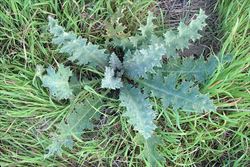
rosette of lower leaves (Photo: Sheldon Navie)
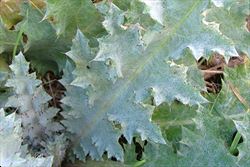
close-up of prickly leaves (Photo: Sheldon Navie)
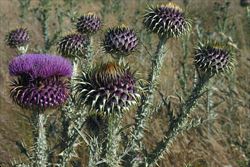
upper leaves, winged stems and flower-heads (Photo: Jackies Miles)
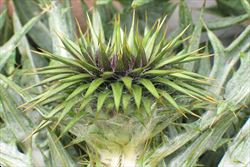
close-up of young flower-head with broad spines (Photo: Jackies Miles)
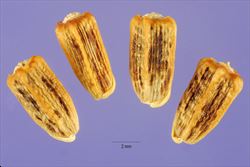
close-up of seeds without hairs (Photo: Steve Hurst at USDA PLANTS Database)
Scientific Name
Onopordum illyricum L. subsp. illyricum
Synonyms
Onopordon illyricum L.Onopordum illyricum L.
Family
Asteraceae (Queensland, New South Wales, the ACT, Victoria, Tasmania, Western Australia and the Northern Territory)Compositae (South Australia)
Common Names
cotton thistle, Illyrian cottonthistle, Illyrian thistle
Origin
Native to southern Europe (i.e. France, Portugal, Spain, Albania, Bulgaria, Greece, Italy and Yugoslavia) and western Asia (i.e. Cyprus, Syria and Turkey).
Naturalised Distribution
Widely naturalised in south-eastern Australia, particularly in sub-coastal regions. It is most common in the sub-coastal regions of eastern New South Wales, south from the Quirindi area. Also present in Victoria, the ACT, and in some southern parts of South Australia.
Naturalised overseas in south-western USA (i.e. California).
Notes
While Illyrian thistle (Onopordum illyricum subsp. illyricum) is mainly a weed of agricultural areas, it is also listed as a priority environmental weed in at least one Natural Resource Management region. This species was probably introduced into Australia as a garden ornamental in the early 1800's. It quickly escaped cultivation and is now a widespread weed of pastures, roadsides, disturbed sites and wastelands.
Illyrian thistle (Onopordum illyricum subsp. illyricum) is particularly prominent in pastures in the temperate tableland regions in south-eastern Australia. It is a strong competitor and is able to establish in grassland communities, particularly those that are disturbed by heavy grazing. In native pastures, the broad flat rosettes of this species smother surrounding plants, and in over-grazed areas its can form dense stands which replace all other vegetation.

